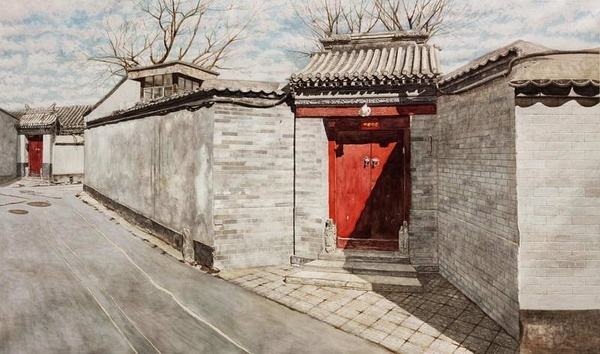Top 10 Famous Hutongs in Beijing

Crisscrossing hutongs and old courtyards form the living places of the natives in Beijing. Many folk activities still remain there.
In central Beijing, there are two main areas for the ancient small alleys - one is the Shichahai and Bell / Drum Towers Area not far to the north of the Forbidden City, and the other is the Qianmen and Dashilar Area to the south of the Tiananmen Square.
South Gong and Drum Lane (Nanluogu Xiang)
This old lane is renowned for its long history, culture, specialty stores, and distinctive foods. It is 2,582 feet (787 meters) long and 26 feet (8 meters) wide, with its north end joining East Drum Tower Street, and the south end connecting East Di'anmen Street. This alley is also called Centipede Street because of the eight alleys symmetrically arranged on the two sides of the major lane.
Skewed Tobacco Pouch Street (Yandai Xiejie)
It measures 761 feet (232 meters) long, connecting Di'anmen Outer Street at the east end and the junction of Xiaoshibei and Ya'er Hutongs at the west end. The slender street is like a pipe's stem, stretching from northeast to southwest, and its east end looks like the pipe's mouth. Besides, there used to be a bunch of pipe shops in late Qing Dynasty (1644 – 1911). So, people called this street Skewed Tobacco Pouch. Today, many different kinds of bars, tea houses, coffee rooms and souvenir shops have mushroomed on the street.
Mao'er Hutong
It is in the northwest of Dongcheng District, stretching 1,919 feet (585 meters) from South Gong and Drum Lane to Di'anmen Outer Street. A lot of celebrities have lived there, such as Wan Rong - the last empress, Feng Guozhang - a leader of the Northern Warlords (1912-1926), and Hong Chengchou - a general in the Ming Dynasty (1368 –1644). Many of their former residences remain there.
Guozijian Street
Guozijian Street is to the west of Yonghe Temple, with its east end joining Yonghe Lamasery Street while the west end adjoins Andingmen Inner Street. The street is 2,195 feet (669 meters) in length and 36 feet (11 meters) in width. It is the only old alley in Beijing that still has traditional arches. Guozijian Street is renowned for its old-time Beijing layout and architectures, authentic native lifestyle, Temple of Confucius and Imperial Academy (Guozijian).
Liulichang Cultural Street (Colored Glaze Factory Culture Street)
This alley has a long history, located outside Heping Gate. Early in the Liao Dynasty (916 - 1125), it was a village called 'Haiwang'. Then, a colored glaze factory was set up there and thus the name of the alley. Later, it became an antique market. Nowadays, nearly 100 time-honored brands are still there, such as Rongbao Zhai - containing precious calligraphy and paintings, Yungu Zhai - housing quaint enamels and porcelains, and Yuehai Xuan - selling traditional musical instruments.
Jinyu Hutong (Goldfish Hutong)
With its east end joining North Dongdan Street while the west end adjoins Wangfujing Street, it measures 1,860 feet (567 meters) long. It is wider than other alleys in Beijing and houses the famous Jixiang Theater, Peninsular Hotel, and Novotel Peace Hotel.
Dongjiaomin Lane (Dongjiaomin Xiang)
Together with Xijiaomin Lane, they are called the longest hutong in Beijing, with a length of 9,843 feet (3 kilometers). Stretching from East Tiananmen Square Road to Chongwenmen Inner Street, Dongjiaomin Lane used to be the location of many foreign embassies. There are also sites of old churches, banks, official mansions and clubs. Buildings there form the only European style block in Beijing, which contains the early 20th-century features.
Xijiaomin Lane (Xijiaomin Xiang)
It is an east-west alley starting from West Tiananmen Square Road to North Xinhua Street, measuring 3,543 feet (1.08 km) in length. More than ten banks were set on this alley from late Qing Dynasty to late 20th century, making it the 'Financial Street of old Beijing'. There are many sites of old banks, such as Central Bank, Continental Bank, and Commercial Guarantee Bank of Beiyang Government.
Ju'er Hutong
With a length of 1,437 feet (438 meters), it starts from Jiaodaokou South Street in the east and ends at South Gong and Drum Lane in the west. It houses the former residence of Rong Lu, a minister in the late Qing Dynasty, including his mansion, ancestral hall, and garden.
Bada Hutong (Eight Great Hutongs)
Once the synonym for the red-light district in old Beijing, it refers to an area to the west of Guanyin Temple and near Dashilar Street outside Qianmen Gate. This area features eight alleys from west to east named Baishun, Yanzhi, Hanjia, Shaanxi, Stone (Shitou), Zongshu Xiejie, Zhujia, and Xiaoli.
